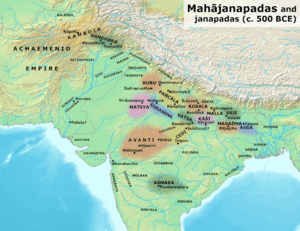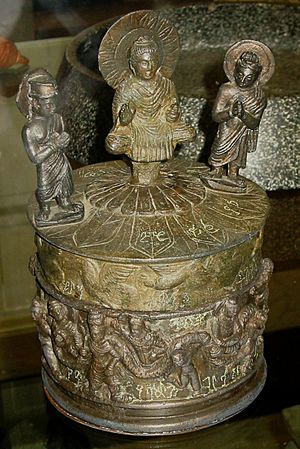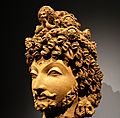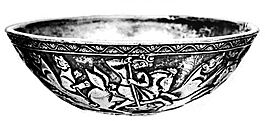Gandhara facts for kids
Quick facts for kids Gandhāra
Gandhara
|
|
|---|---|
| c. 1200 BCE–c. 1001 CE | |
| Capital | Puṣkalavati Puruṣapura Takshashila Udabhandapura |
| Government | |
| Raja | |
|
• c. 550 BCE
|
Pushkarasarin |
|
• c. 330 BCE
|
Taxiles |
|
• c. 321 BCE
|
Chandragupta Maurya |
|
• c. 46 CE
|
Sases |
|
• c. 127 CE
|
Kanishka |
|
• c. 514 CE
|
Mihirakula |
|
• c. 964 CE
|
Jayapala |
| Historical era | Antiquity |
|
• Established
|
c. 1200 BCE |
|
• Disestablished
|
c. 1001 CE |
| Today part of | Pakistan Afghanistan |
Gandhara (IAST: Gandhāra) was an ancient civilization located in what is now northwest Pakistan and northeast Afghanistan. It was a very important place for the spread of Buddhism to Central and East Asia. Many Chinese Buddhist travelers visited this region.
The main language spoken here was Gāndhārī, an Indo-Aryan language. It was written using the Kharosthi script. This language spread as far as China because of Buddhism. Gandhara was also famous for its special Gandharan style of art. It was most powerful and artistic from the 1st to the 5th century CE under the Kushan Empire. Their capital was Puruṣapura, and this time was known as Pax Kushana, meaning "Kushan Peace."
The history of Gandhara began with the Gandhara grave culture, known for its unique burial customs. During the Vedic period, Gandhara became one of the sixteen 'great realms' in South Asia. It even played a role in the Kurukshetra War. In the 6th century BCE, King Pukkusāti ruled Gandhara. He was famous for defeating the Kingdom of Avanti.
Later, Gandhara became a part of the Achaemenid Empire. When Alexander the Great came, Gandhara was divided. The king of Taxila, Taxiles, joined Alexander. But tribes in Western Gandhara, like the Aśvaka in the Swat valley, fought against him. After Alexander's empire fell, Gandhara became part of the Maurya Empire. Chandragupta Maurya, who later became a great emperor, studied in Taxila.
Over time, different groups ruled Gandhara, including the Indo-Greeks, Indo-Scythians, and Indo-Parthians. A local Gandharan kingdom, the Apracharajas, also ruled during this time. The Kushan Empire then took over, and Gandhara reached its peak. However, it was later destroyed by the Hunnic Invasions. The region later saw a comeback under the Turk Shahis and Hindu Shahis.
Contents
- What Does Gandhara Mean?
- Where Was Gandhara Located?
- A Look at Gandhara's History
- Early Beginnings: The Grave Culture
- Gandhara in Ancient Texts
- King Pukkusāti and Persian Rule
- Alexander the Great's Arrival
- Gandhara Under the Mauryan Empire
- Greek Influence: The Indo-Greek Kingdom
- Local Rulers: The Apracharajas
- The Golden Age: Kushan Gandhara
- Later Rulers: Kidarites and Huns
- Turk and Hindu Shahis
- Rediscovering Gandhara
- Gandhara's Culture
- Main Cities of Ancient Gandhara
- Famous People from Gandhara
- See also
What Does Gandhara Mean?
The name Gandhara comes from the Sanskrit word gandhaḥ, which means "perfume." This might refer to the spices and herbs that people there traded. The Gandhari people were a tribe mentioned in ancient texts like the Rigveda.
Where Was Gandhara Located?
The location of Gandhara changed over time. Generally, it was between the Pothohar Plateau in Punjab, the Swat valley, and the Khyber Pass. It also stretched along the Kabul River. Important cities were Taxila and Pushkalavati. Some ancient stories even say it included parts of Kashmir.
The term Greater Gandhara refers to the larger area where Gandharan culture and language spread. This included regions like Jibin and Oddiyana, and even parts of Bactria and the Tarim Basin.
A Look at Gandhara's History
Early Beginnings: The Grave Culture
The earliest known culture in Gandhara was the Grave Culture, which existed from about 1200 BCE to 800 BCE. It's named after their special ways of burying the dead. This culture was mainly found along the Swat River.
Gandhara in Ancient Texts
The Gandhari people are first mentioned in the Rigveda, an ancient Indian text. They were known for their sheep with good wool. Later, in the Atharvaveda, they are mentioned as a distant tribe. The Zoroastrian text Avesta also mentions Gandhara as Vaēkərəta, calling it one of the most beautiful places on Earth.
By the later Vedic period, the city of Takṣaśila in Gandhara became a major learning center. People from other regions came here to study. Famous philosophers like Uddālaka Āruṇi studied in Takṣaśila. In the 6th century BCE, Gandhara was a powerful kingdom in South Asia. Buddhist texts listed it as one of the sixteen Mahajanapadas or "great realms."
King Pukkusāti and Persian Rule
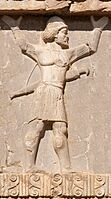
In the 6th century BCE, King Pukkusāti ruled Gandhara. Buddhist stories say he made friends with the kingdom of Magadha and won battles against other kingdoms. His kingdom was very large, and his capital was Taxila.
Some historians believe Pukkusāti might have fought against the Persian Empire. However, Gandhara eventually became part of the Persian Empire under Darius I. It became a Persian province called a "satrapy" with its capital at Pushkalavati. During Persian rule, the Kharosthi script, used for the Gandhari language, was created from the Aramaic alphabet.
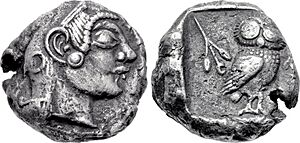
Gandharan soldiers even fought in the Second Persian invasion of Greece under King Xerxes I.
Alexander the Great's Arrival
When Alexander the Great arrived in 327 BCE, the area of Gandhara had two main tribes: the Assakenoi and Astakanoi. The king of Taxila, Omphis, became an ally of Alexander. He helped Alexander cross the Indus River.
However, other tribes like the Aspasians and Asvakas fought fiercely against Alexander. The city of Massaga was a strong fort for the Asvakas. Even though a peace treaty was made, Alexander broke it, and a big battle followed. The Asvakas, including women, fought bravely but were defeated.
Gandhara Under the Mauryan Empire

During the Mauryan period, Gandhara was a very important part of the empire. Taxila was the capital of the northwest region. Chanakya, a key figure in creating the Mauryan Empire, adopted Chandragupta Maurya. Chandragupta received a full education and military training in Taxila for many years.
Buddhist traditions say that Chanakya was from Taxila. After Alexander's death, Chanakya and Chandragupta formed an army, including Gandharans, to conquer the Nanda Empire.
Later, during the reign of Bindusara, there was a rebellion in Taxila. Ashoka, who would become a great emperor, was sent to stop it. The people told him they were rebelling against bad ministers, not against the king. When Ashoka became emperor, he put up many rock edicts in the Kharosthi script in Gandhara. He also built a huge stupa (a Buddhist monument) in Pushkalavati.
After Ashoka's death, the northwestern region broke away from the Mauryan Empire. Kings like Virasena and Subhagasena ruled. Subhagasena even had ties with the Greeks.
Greek Influence: The Indo-Greek Kingdom

The Indo-Greek king Menander I (155–130 BCE) took control of Gandhara. His kingdom lasted for a while, but eventually, the last independent Greek king disappeared around 10 CE. During this time, Greek and South Asian cultures mixed, especially in Gandhara. This blend can be seen in their art and beliefs.
Local Rulers: The Apracharajas
The Apracharajas were a local dynasty in Gandhara. They ruled from the time of the Indo-Greeks until the early Kushans. They were strong supporters of Buddhism, as shown by many donations found in their main area between Taxila and Bajaur.
Indo-Scythian Kingdom
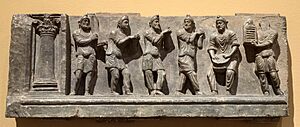
The Indo-Scythians were people from Central Asia who moved into South Asia. They took over from the Indo-Greeks and ruled a kingdom from Gandhara to Mathura. The first Indo-Scythian king, Maues, became very powerful.
Some Apracharaja rulers, like Indravarma, were generals under the Indo-Scythians. Indravarma even received a silver reliquary (a container for relics) from the Indo-Scythian king Kharahostes. He later made it a Buddhist reliquary, showing his support for Buddhism.
Indo-Parthian Kingdom
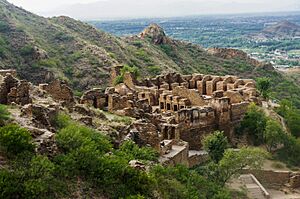
The Indo-Parthian Kingdom was ruled by the Gondopharid family. Their main city was Taxila, but later it moved to Kabul or Peshawar. Their coins were similar to those of the Parthian Empire.
During this time, the Apracharaja ruler Sases became important. He was a nephew of Aspavarma, an earlier Apracharaja general. Sases later became one of the successors to the Indo-Parthian king Gondophares.
Travelers visiting Gandhara in 46 AD noted that the people were wealthy. They used coins made of special metals. The city of Taxila was described as being walled like a Greek city, with narrow roads.
The Golden Age: Kushan Gandhara
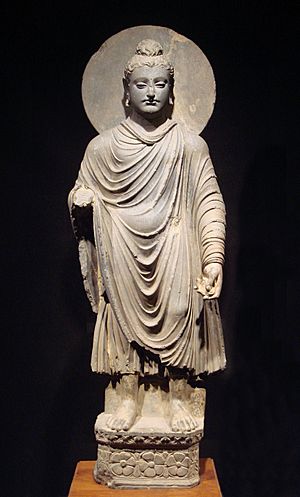
The Kushans took over Gandhara after being defeated in Central Asia. Kujula Kadphises united the Kushan tribes and conquered other regions, including parts of Gandhara. His son, Vima Takto, took over from the Apracharajas in Taxila.
The Kushan period is known as the Golden Period of Gandhara. Many ruins of stupas and monasteries from this time can be found in the Peshawar Valley and Taxila. Gandharan art became very famous, creating some of the best sculptures in the region.
Gandhara's culture reached its peak under the great Kushan king Kanishka the Great (127 CE – 150 CE). The cities of Taxila and Purushapura (modern-day Peshawar) grew very large. Purushapura became one of the capitals of the vast Kushan Empire.
Emperor Kanishka was a strong supporter of Buddhism. Buddhism spread from India to Central Asia and the Far East through his empire. Buddhist art from Gandhara influenced other parts of Asia. During this time, Mahayana Buddhism became popular, and Buddha was shown in human form. New Buddhist stupas were built, and old ones were made larger. Huge Buddha statues were created. Kanishka also built the 400-foot Kanishka Stupa in Peshawar, which was one of the tallest buildings in the ancient world.
Later Rulers: Kidarites and Huns
The Kidarites conquered Peshawar and parts of Gandhara between 390 and 410 CE. Their last ruler in Gandhara was Kandik around 500 CE.
Around 430 CE, the Alchon Huns took control of routes across the Hindu Kush. Coins of Alchon rulers have been found in Buddhist monasteries, showing their presence.
However, the Alchons later destroyed many Buddhist monasteries and stupas in Taxila. This center of learning never fully recovered. The Kanishka stupa was likely destroyed by them in the 460s CE. The Alchon ruler Mihirakula was known for persecuting Buddhists. Chinese monk Xuanzang reported in 630 CE that Mihirakula ordered the destruction of Buddhist sites. When Xuanzang visited Gandhara, he found most monasteries empty and in ruins.
Turk and Hindu Shahis
The Turk Shahis ruled Gandhara until 870 CE. Then, the Hindu Shahis took over. The Hindu Shahis moved their capital to Hund. At its strongest, their kingdom included the Kabul Valley, Gandhara, and western Punjab.
King Jayapala of the Hindu Shahis saw the rising power of the Ghaznavids (a Muslim empire). He attacked their capital, Ghazni, but was defeated. He lost control of the region between the Kabul River and the Indus River.
In 1001, Jayapala attacked Ghazni again but was defeated by Mahmud. After this defeat, he died. His son, Anandapala, and later generations continued to fight the Ghaznavids but were unsuccessful. The Hindu rulers eventually moved to the Kashmir hills.
Rediscovering Gandhara
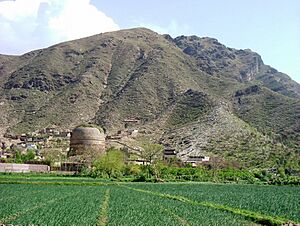
By the time Gandhara became part of Mahmud of Ghazni's empire, its Buddhist buildings were already in ruins, and its art was forgotten. In the 19th century, British soldiers and officials became interested in the ancient history of the Indian Subcontinent.
In the 1830s, ancient coins were found, and Chinese travel writings were translated. Scholars like Charles Masson and Alexander Cunningham deciphered the Kharosthi script in 1838. Chinese records gave clues about Buddhist shrines. These clues, along with the coins, helped piece together Gandhara's history. In 1848, Cunningham found Gandharan sculptures north of Peshawar. He also identified the site of Taxila in the 1860s. Many Buddhist statues were then discovered in the Peshawar valley.
Archaeologist John Marshall excavated at Taxila from 1912 to 1934. He found separate Greek, Parthian, and Kushan cities, along with many stupas and monasteries. These discoveries greatly helped understand Gandhara's history and art.
After 1947, researchers from the University of Peshawar made more discoveries in the Peshawar and Swat Valley. Today, many sites of the Gandhara Civilization are still being excavated by researchers from around the world.
Gandhara's Culture
Language of Gandhara
The language of Gandhara was a dialect called Gāndhārī. It was a "Middle Indo-Aryan" language. Under the Kushan Empire, Gāndhārī spread to nearby regions. It used the Kharosthi script, which came from the Aramaic alphabet. This script stopped being used around the 4th century CE.
Today, Hindko, spoken in Peshawar, has strong ties to the ancient Gandhara language. It developed from an older language called Shauraseni Prakrit, which was based on Sanskrit. Inscriptions from Gandhara show how ancient languages are linked to modern Hindko.
Some Dardic languages also have links to Gandhari. The Kohistani languages, once common in the region, likely came from ancient Gandharan dialects.
Religion in Gandhara
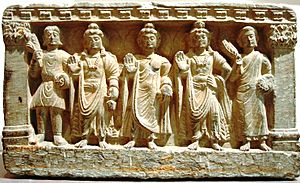

Mahāyāna Buddhism
Mahāyāna Buddhist texts were brought from Gandhara to China as early as 147 CE. A Kushan monk named Lokakṣema translated some of the first Buddhist texts into Chinese. These early translations show they came from the Gāndhārī language. Lokakṣema translated important Mahāyāna texts about meditation and spiritual practices.
Some scholars believe that the Longer Sukhāvatīvyūha Sūtra was created in the Kushan Empire around the 1st and 2nd centuries CE. There are also images of Amitābha Buddha with other important figures that were made in Gandhara during the Kushan era.
The Mañjuśrīmūlakalpa says that King Kaniṣka of the Kushan Empire helped establish Mahāyāna teachings in the northwest. This suggests that Mahāyāna Buddhism was strong in Gandhara during this time.
Art of Gandhara
Gandhara is famous for its special Gandhāra style of Buddhist art. This art shows a mix of Greek and local Indian styles. Gandharan art was most popular during the Kushan Empire (1st to 5th centuries CE). However, it declined and was destroyed after the Alchon Huns invaded in the 5th century.
A common theme in Gandharan art is Siddhārtha (the Buddha before he became enlightened) shown as a prince wearing jewels. Sculptors in Gandhara used stucco and stone to decorate temples and buildings. Buddhist images were combined with Greek art elements. For example, the young Buddha was often shown with wavy hair, similar to Greek statues of Apollo.
The art of Gandhara developed in different stages:
- Indo-Greek art: 2nd century BCE to 1st century CE
- Indo-Scythian art: 1st century BCE to 1st century CE
- Kushan art: 1st century CE to 4th century CE
-
The Greek god Atlas, supporting a Buddhist monument, Hadda.
-
The Bodhisattva Maitreya (2nd century).
-
The Buddha preaching at the Deer Park in Sarnath (2nd–3rd century).
-
The Bodhisattva and Chandeka, Hadda (5th century).
-
The Seated Buddha, from 300 to 500 CE, found near Jamal Garhi. Now in the Asian Art Museum in San Francisco.
-
Sharing of the Buddha's relics, above a Gandhara fortified city.
Main Cities of Ancient Gandhara
Here are some of the major cities of ancient Gandhara:
- Puṣkalavati (Charsadda), Pakistan
- Takshashila (Taxila), Pakistan
- Puruṣapura (Peshawer), Pakistan
- Sagala (Sialkot), Pakistan
- Oddiyana (Swat), Pakistan
- Kapisi (Bagram), Afghanistan
- Jibin, mentioned in Chinese records
- Chukhsa (Chhachh), Pakistan
- Attock Khurd (Attock), Pakistan
- Hund (Swabi), Pakistan
- Bajaur, capital of (Apraca), Pakistan
- Aornos, somewhere in Hazara, Pakistan
Famous People from Gandhara
See also
- History of Pakistan
- History of Punjab
- Apracharajas
- History of Afghanistan



